Research Projects
The CTSDH supports and sponsors a series of online research projects in Textual Studies and Digital Humanities. These projects include, but are not limited to, digitization, text editing, tool building, critical analyses, and archive construction. They are created with a mix of internal and external funding, and interdisciplinary co-sponsorship. They typically involving affiliated Loyola faculty, staff, graduate and undergraduate students, in various areas and disciplines from across the university. If you want to house a project at the CTSDH, please check the 'Start a Project' page. Want to sample Digital Humanities in your classroom? Look at some of the ways we have done so in the past, on the 'DH in the Classroom' page.
Projects
Dickinson's Birds: A Public Listening Project
Project Director: Dr. Marta Werner
Status: awarded a Research Support Grant by Loyola's Office of Research Services in Spring 2020
Project Description:

Of the more than 500 species of birds known to nest in the fertile Connecticut River Valley or pass through it on their long migrations, Emily Dickinson named a relatively small number of them, possibly just those she heard from her window or observed in her garden: robins, bobolinks, sparrows, jays, crows, eagles, cardinals, orioles, larks, phoebes, black- and blue-birds, lapwings, hummingbirds, owls, eider ducks, swans, whippoorwills, partridges, cuckoos, doves, linnets, and wrens. Yet birdsong is arguably the most constant evanescent sound she recorded through writing in an age before the technologies of recording had been invented.
Following the searching work of Andrew Whitehouse (2015) in his anthropological investigation of the significance of bird sounds to contemporary people’s sense of place and time as well as of the ways in which the diminishment of bird sounds triggers anxieties innate in the Anthropocene’s vision of nature’s finitude, “Dickinson’s Birds: A Public Listening Project” undertakes the identification, archiving, and un-archiving of bird sounds in Dickinson’s text-, land-, and sky-scapes to enlarge our understanding of the relationship between Dickinson’s bird-poems, her evolving sense of emplacement, and her intuition of the long approach of the Anthropocene through the widespread ecological changes of the Industrial Revolution, while also encouraging us to sound out our contemporary experience of loss and mourning for a planet now suffering profoundly from the effects of climate change, loss of biodiversity, and environmental degradation.
Ultimately, however, this is an experiment in hope rather than an exercise in despair. To this end, “Dickinson’s Birds” also attends to those soundings, however faint, that propose new pathways for moving forward in the altered world we have createdand of mapping the ways in which our sharp expectancy of the Sixth Mass Extinction may lead to greater attunement to and ethical interaction with the beings with whom we share an uncertain future. Here the archive itself is re-imagined not as a repository of static and isolated information essential for the preservation of human history but as an open, living environment that shelters traces of both the human and the non-human even in their imagining of their own endings and new beginnings.
Fields: Textual studies, mapping, timeline, ecocentric digital humanities, literary analysis
Best Kids’ Films Website
Project Directors: Dr. Bren Ortega Murphy
Status: In development
Funding: The Gannon Center for Women & Leadership, Women Studies & Gender Studies
Project Description:

This project involves the creation of a website that will serve as a reference for parents, teachers, and other caregivers who are looking for films that are really worth watching. The site identifies films that children should see based on values of social justice that are at the core of Jesuit education. These include
- Recognition of the worth of all people regardless of gender, race/ethnicity, religion, and economic status
- The value of a wide range of families and communities
- The importance of critical thinking and ethical discernment
- The importance of learning through experience
- The value of art as film
- The necessity to strive for justice for all
We believe that this resource will expand viewing options well beyond films that are heavily promoted through advertising and commercial spin-offs.
Fields: textual analysis, ethics, gender studies
The Amy Lowell Letters Project: Digitizing a Career in Poetry
Project Director: Dr. Melissa Bradshaw
Status: Launched in Fall 2019, ongoing
Project Description:
The Amy Lowell Letters Project (ALLP) is an open-access, digital scholarly edition of the letters of American poet, editor, and critic Amy Lowell (1874–1925). This project transcribes, annotates, and encodes letters written by Lowell, archived in her collected papers at Harvard University’s Houghton Library (MS Lowell 19.1). The letters have been scanned by Houghton Library from Lowell’s papers, and can be viewed through Harvard’s HOLLIS for Archival Discovery.
Her letters show the many roles she played as a poet, editor, critic, and de facto literary agent, involved in everything from designing book covers, to writing ad copy, advising marketing plans, and negotiating royalties.
Lowell’s collected correspondence is massive, containing almost 3,000 letters, almost half of which are written by Lowell and therefore open to use for this project. The initial phase of “The Amy Lowell Letters Project” (ALLP) will focus tightly on the years of Lowell’s career, 1910-1925, showcasing letters that offer insights into the battles, both public and private, surrounding modern poetry, and dramatizing Lowell’s role in the development and dissemination of a controversial, experimental poetics. Her letters show her in conversation with some of best-known American and European poets of the early twentieth century, discussing, reworking, and usually arguing about works we now consider canonical. But they also show her engaged in equally impassioned conversations with once prominent literary figures less well known today. Perhaps most importantly, her letters show the depth and complexity of her relationships with behind-the-scenes players whose roles in establishing what we now consider the modernist poetry canon are usually underrepresented or overlooked: editors of both little magazines and popular weeklies, heads of publishing houses, newspaper columnists, translators, booksellers, literature professors, and book sellers.
ALLP asks, how might correspondence metadata reveal the labor behind the modernist poetry canon: the queries, submissions, revisions, rejections, and financial transactions that bridge artistic creation and public consumption? More specifically, how might correspondence metadata from Lowell’s archive map professional relationships among modern poets, trace the lifecycle of poems, from drafts to publication, and support feminist recovery work by demonstrating the centrality of an overlooked literary figure?
Over the past year Bradshaw and a team of graduate students in Digital Humanities and English here at Loyola University Chicago have worked to develop the infrastructure for ALLP. They have transcribed hundreds of Lowell’s letters from facsimile to text, written the TEI header, designed encoding guidelines and a work flow, encoded sample letters, created a site index, and built a wire frame.
For more, see the ALLP GitHub page and follow Amy Lowell Says (@lowell_says) on Twitter.
Fields:
The Charles Harpur Critical Archive (CHCA)
The Charles Harpur Critical Archive (CHCA) is a digital archive and a scholarly edition of the poetic works of Charles Harpur (1813-68), the most important poet of colonial New South Wales, whose works up to this point have not been easily accessible to the general public. A Romantic celebrator of Australian landscape, a political satirist, a love poet and early environmentalist, Harpur and his works remain relevant today.
Status: Launched in 2017
Project Team:
- Editor and project leader: Paul Eggert
- Technical designer and programmer: Desmond Schmidt
- Digital archivist: Meredith Sherlock
- Principal collaborators: Michael Falk (poem assessments), Chris Vening (biographical entries, historical annotation), Elizabeth Webby (adviser)
Website: http://www.charles-harpur.org/
Field(s): critical infrastructure, textual scholarship, digital archives, participatory community
Codename Revolution
Co-authored by the two founding co-directors of the CTSDH, Codename Revolution: The Nintendo Wii Platform (MIT Press, 2012) explores the reciprocal relationship of gaming hardware to the artists working on these platforms. Steven Jones and George Thiruvathukal approached this book as an experiment in applying a dual media studies and computer science approach to the study of a computing platform with a wide cultural influence.
The Nintendo Wii, introduced in 2006, helped usher in a moment of retro-reinvention in video game play. This hugely popular console system, codenamed Revolution during development, signaled a turn away from fully immersive, time-consuming MMORPGs or forty-hour FPS games and back toward family fun in the living room. Players using the wireless motion-sensitive controller (the Wii Remote, or “Wiimote”) play with their whole bodies, waving, swinging, swaying. The mimetic interface shifts attention from what’s on the screen to what’s happening in physical space. This book describes the Wii’s impact in technological, social, and cultural terms, examining the Wii as a system of interrelated hardware and software that was consciously designed to promote social play in physical space.
Each chapter of Codename Revolution focuses on a major component of the Wii as a platform: the console itself, designed to be low-powered and nimble; the iconic Wii Remote; Wii Fit Plus, and its controller, the Wii Balance Board; the Wii Channels interface and Nintendo’s distribution system; and the Wii as a social platform that not only affords multiplayer options but also encourages social interaction in shared physical space. Finally, the authors connect the Wii’s revolution in mimetic interface gaming—which eventually led to the release of Sony's Move and Microsoft’s Kinect—to some of the economic and technological conditions that influence the possibility of making something new in this arena of computing and culture.
Project Directors: Steven E. Jones and George V. Thiruvathukal
Website: https://mitpress.mit.edu/books/codename-revolution
Field(s): gaming studies, human computer interaction, software engineering.
Digitizing the May Weber Collection
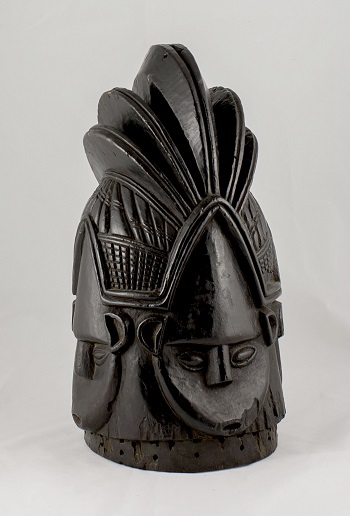
In 2012, Loyola University Chicago received a collection of approximately 2500 cultural art objects to be curated by the Department of Anthropology from the Chicago-based collector and museum curator/director, May Weber. The May Weber Ethnographic Study Collection serves as an educational and research resource for students, faculty, and the public. The collection contains the work of hundreds of indigenous artists from communities in the Americas, Africa, Asia, and the Pacific. It is particularly strong in Mexican festival masks and Asian textiles, particularly from India and Southeast Asia.
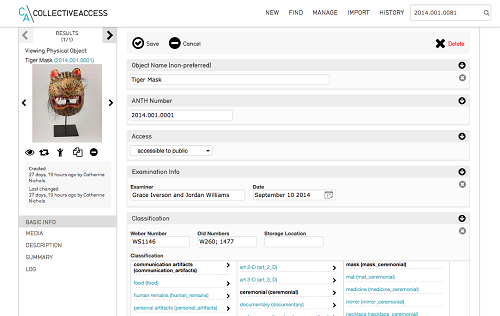
For students of anthropology, fine art & art history, history, or regional studies, the collection offers many routes of study, from folk art traditions to the ceremonial use of objects. Like most collections of its kind, the Weber Collection has been collected, curated, catalogued, and cared for under the guise of a Western scientific and aesthetic framework.
LUC now serves as its permanent home, and we seek to leverage university resources to implement decolonial practices surrounding its perpetual care and use in order to engage with and make it accessible to the source communities represented in the collections.

Under the direction of Dr. Catherine Nichols, lecturer in the Department of Anthropology, the CTSDH is supporting the development of collections management system using the open access program CollectiveAccess. This cataloguing interface provides robust and highly customizable descriptive fields, emphasizing visual accessibility. The initial phase of the project is the digitization of collection objects and associated documentation. Upon completion, we will implement phases rooted in decolonial methodologies, experimenting with affective lexicons, folk taxonomies, and source community-driven projects.
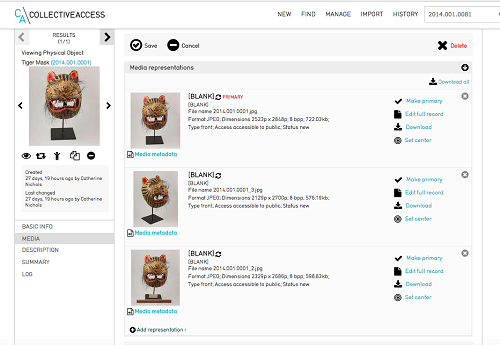
Project Director: Catherine Nichols
Website: Yet to be launched (expected 2021)
A companion project is East Asian Textiles, a DH capstone project by Xiaolin Sun that provides access and information to 84 textiles from the Weber Collection.
Fields: critical curation, digitization, metadata
Digitizing the Michalak Collection

This collaborative project of the Center for Textual Studies and Digital Humanities and the Loyola University Libraries aims to preserve, digitize, and make accessible via multiple platforms a rich collection of late eighteenth- and early-nineteenth-century political cartoons and pamphlets generously donated to Loyola University Archives and Special Collections by Thomas J. and Jo-Ann Michalak.
The Michalak Collection of Nineteenth-Century British caricature and satire features broadsides and books with illustrations by such leading artists as James Gillray (1757-1815), Isaac Cruikshank (1764-1811), Robert Cruikshank (1789-1856), George Cruikshank (1792-1878), John Leech (1817-1864), and others. This collection is particularly rich in materials related to the Napoleonic Wars (1803-1815), capturing the reaction of the British to the French military leader and emperor’s aggressive expansion across Europe and in the colonies.
Under the supervision of University Archivist Kathy Young and Douglas Guerra (English PhD ‘12), the project has digitized an initial group of 66 prints, and those digital images with metadata are now publicly available in Loyola’s Digital Special Collections.
The digitized broadside prints are part of a much larger collection donated by the Michalaks. Consisting of over 1000 objects which includes political cartoons, graphical satires, illustrated books and pamphlets, finding aids, and reference works, the collection is housed in University Archives and Special Collections.

Project Director: Kathy Young
Website: http://content.library.luc.edu/cdm/landingpage/collection/coll32
Field(s): critical curation, digital archives, digitization, metadata
Gerard Manley Hopkins Site

This new project’s endeavor is to create an official website for renowned English Jesuit poet Gerard Manley Hopkins. It will bring together critical readerships of his works from around the world in a website entirely dedicated to the poet, his work, and the people who engage with it.
The Gerard Manley Hopkins website will gather a plethora of aspects of scholarship and analysis of the poet’s body of work. Scholars, students, and Hopkins enthusiasts will be enabled to exchange ideas, readings, interpretations, and their own work. The website will facilitate communication about the popular Jesuit poet, but also aims to inform broader audience about Hopkins’s life and work through biographies and excerpts from his most influential work.
Project Director: Francis Fennell
Field(s): Textual scholarship, scholarly communication
Funding: Grants from the Joan and Bill Hank Center for the Catholic Intellectual Heritage, the College of Arts and Sciences, and Loyola’s Jesuit Community
HRIT-CaTT
HRIT-CaTT stands for Humanities Research Infrastructure and Tools (HRIT) and Collaborative Tagging Tool (CaTT). These intertwined projects aim to develop an online open-source, collaborative, robust environment in which to aggregate, link or cross-reference, edit, and share vetted primary documentary texts--along with their scholarly enhancements, analyses, and commentaries, in the form of markup, annotation, keyword tagging, linking and other functions.
A part of the HRIT-CaTT project is Mojulem, a content management framework designed to aid in the development, organization, and publication of digital humanities projects and digital knowledge sites. Mojulem has been designed to conform, where possible or practical, with HRIT principles. Development of Mojulem is an ongoing project in itself, and each new test project adds further requirements.
CaTT (Collaborative Tagging Tool) is an online editor for scholarly editing, will be developed and published as a plugin/module for the Mojulem content management framework. It has been designed to allow an editor/editors to create or import plain or marked-up texts, and add standoff markup applied at character level. The CaTT editor will join an existing set of tools for creating, manipulating, and rendering electronic surrogate archives and editions for literary texts.
Project Directors: Peter Shillingsburgh, Nick Hayward, George Thiruvathukal
Website: https://sites.google.com/a/ctsdh.luc.edu/hrit-intranet/
Field(s): critical infrastructure, metadata
Jesuit Libraries Project
The Jesuit Libraries Provenance Project is a collaborative research and teaching project dedicated to uncovering the history of acquisition and use of Loyola’s original library books. Students, faculty, and staff work together to make available information about these foundational collections through a virtual library system, a digital archive of provenance marks, and a website devoted to scholarship on these books by undergraduate and graduate interns.
The Jesuit Libraries Project recreates the original library catalog of St. Ignatius' College (forerunner to Loyola University Chicago) in an innovative virtual library system. The c.1878 catalog, now in the collections of Loyola University Archives and Special Collections, records approximately 5100 titles, encompassing over 8000 volumes. It is arranged in six sections – Pantology, Theology, Legislation, Philosophy, Literature, and History – that reflect the way in which Jesuits taught and gave order to the world of knowledge. These divisions raise important questions about late nineteenth-century urban Jesuit and Catholic education, intellectual life, and transnational identity. The Project began in 2012 and will launch later in 2016.
In the course of creating the virtual library system, students discovered that upwards of 1750 original books potentially survive in the Loyola university libraries today — in Special Collections, in the Library Storage Facility, even still circulating in the main stacks of the Cudahy Library. The Jesuit Libraries Provenance Project (JLPP) was launched in March 2014 to give students the opportunity to track down, digitize, and create a digital archive (on Flickr) of provenance marks from surviving books. Through the Flickr page and the project website, JLPP team members seek to foster a participatory community of book lovers, collectors, scholars, and students interested in the history of Jesuit-held books.
Lili Elbe Digital Archive
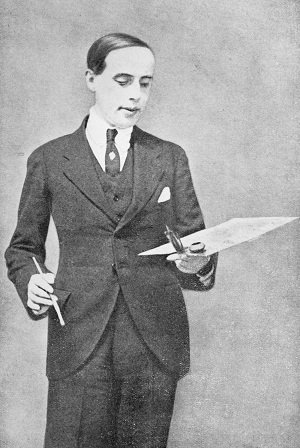
In 1930 Danish artist Einar Wegener underwent a series of surgeries to become Lili Elvenes (more commonly known as Lili Elbe). Her life story, Fra Mand til Kvinde (Man into Woman), published in Copenhagen in 1931, is the first full-length narrative of a subject who undergoes a surgical change in sex.
Produced collaboratively by multiple agents, Fra Mand til Kvinde was re-edited and published in German in 1932 (Ein Mensch wechselt sein Geschlecht), with English-language translations in Britain and the U.S. in 1933 (Man into Woman: An Authentic Record of a Change of Sex). Our digital archive will provide searchable versions of all four editions (Danish, German, British and American) as well as the German typescript and the first English language translation of the Danish edition. Comparing the German typescript and the four versions published in three languages between 1931 and 1933 discloses how a narrative of transgender was shaped by cultural values, linguistic choices, and editorial decisions.
Our comparative scholarly edition makes this historically important work widely available to historians and literary scholars of the early 20th century, to historians and scholars of transgender, and to the general public. The print edition will be published by Bloomsbury Academic (London) with the accompanying digital archive hosted by Loyola University Chicago’s Libraries and supported by the Center for Textual Studies and Digital Humanities.
Project Director(s): Pamela L. Caughie, Sabine Meyer, and Nikolaus Wasmoen, editors
Website: http://www.lilielbe.org/
Field(s): Digital Archive
Modernist Networks
Modernist Networks (ModNets) is a consortium of digital projects in the field of modernist literary and cultural studies. It has the dual goals of establishing a vetting community for digital modernist scholarship and a technological infrastructure to support development of scholarly projects and access to scholarship on modernist literature and culture.
ModNets aims to promote affiliated digital projects; to offer peer review based on content, conception, and technical design; to provide editorial and technical support; to evolve standards and “best practices”; and to maintain a system for the aggregation of scholarly resources in the field.

Digital scholarship in modernist literary and cultural studies has been flourishing, yet until the launch of Modernist Networks in August 2015, there was no coordination between projects, no aggregating infrastructure for information search, no vetting community, and no network of support as exists for digital scholarship in earlier historical periods. By supplying these needs, Modernist Networks supports the development of innovative projects and access to scholarship in the field. ModNets provides a single site where a user can search a whole array of digital modernist projects from a single search box. It also fulfills an important scholarly function by providing peer review for digital projects in modernist literature and culture.
Project Director: Pamela L. Caughie and David E. Chinitz (co-Directors); Niamh McGuigan (Associate Director)
Website: http://www.modnets.org/
Field(s): scholarly communication, metadata, textual scholarship, critical infrastructure
Woolf Online
Woolf Online serves as a digital archive and resource for the study of Virginia Woolf's modernist classic, To the Lighthouse (1927). During the last thirty years or more, Woolf's fiction has generated a massive body of criticism, but surprisingly little of it has drawn upon the extraordinary wealth of surviving source material that Woolf left behind, and the detailed information it can yield as to how her work came to be written. Using the Mojulem software developed by CTSDH faculty, Woolf Online brings together a range of rare material on a digital platform.
Woolf Online expands upon a pilot project focused on the "Time Passes" section of To the Lighthouse, begun by the late Julia Briggs and completed at De Montfort University's Centre for Textual Scholarship in 2008. The pilot project took as its case study a highly experimental passage from one of the greatest twentieth-century novels in the English language, “Time Passes,” which formed the central sequence from Virginia Woolf's novel To the Lighthouse. Woolf composed the first draft of “Time Passes” between 30th April and 25th May 1926, with an interval of four days, between 10th and 13th May, when she was working on an article on De Quincey for the Times Literary Supplement. The pilot project brought together the different stages of writing that went into the making of “Time Passes” to create a record of its development in the form of a genetic edition of the text, and to embed that edition in a network of histories and contexts that reconfigure traditional annotation techniques as a system of linked but separate strands of thought, thus producing a new form of literary archaeology.

Between 2010 and 2013, the project was expanded to cover the novel in its entirety. On this site you will find images and transcriptions of the holograph drafts (in three notebooks housed in the Berg Collection of the New York Public Library), the typescripts, the proofs, and various early editions of the novel, including the first British and American editions and their variants. Also included is a wealth of contextual materials, such as diary entries and letters pertaining to the novel, early reviews of the novel, selected essays Woolf wrote during the two- year period during which she worked on To the Lighthouse, and photographs of the Stephen family, Cornwall, and Talland House, all of which inform the setting and characters of the novel.
Because the three notebooks housed in the Berg Collection are fragile and access to them is now severely limited, Woolf Online performs an especially valuable service by making these drafts available to scholars, students and the public at large in brilliant images, easily legible with the aid of a magnifying feature and easily readable with transcriptions that overlay images of the originals.
Project Director: Pamela L. Caughie and Peter Schillingsburg, Mark Hussey (Pace University); Nick Hayward (chief architect and technical administrator) and George Thiruvathukal.
Website: http://www.woolfonline.com/
Field(s): textual scholarship, text encoding, critical infrastructure
Student Research
At the CTSDH we are committed to nurturing student scholarship in the Digital Humanities and Textual Studies. Below you will find more information about projects undertaken by Loyola undergraduate and graduate students. Browse through and enjoy the diversity of creative work happening by the next generation of digital humanists!
Mapping Catholics with the Jesuit Libraries Provenance Project by Bianca Barcena
Blog Author: Bianca Barcenas
Blog: https://mappingvalleycatholics.wordpress.com/
Field(s): critical curation, digitization, history of the book and print culture, digital mapping
This summer and fall, Bianca Barcenas, an intern for the Jesuit Libraries Provenance Project, is helping analyze and map the rich data on Catholic readers found in an1840s book trade ledger maintained by the Jesuits at St. Louis.
About the Author:
I am a Junior from Portland, Oregon, and came to Chicago to immerse myself in history. History has been my passion ever since elementary school (to eight-year-old me, nothing was cooler than The Titanic or King Tut), so it was no surprise that it became the subject to pursue in college. I really enjoy researching information for papers and projects; I just love learning about historical moments and figures too much! While studying history, I am also pursuing my love of technical theatre at Loyola. Ultimately, I would like to go to graduate school to study Public History, then pursue a career in archives.
Being a part of the Jesuit Libraries Provenance Project will allow me to gain more experience in analyzing archived material. From completing the Ramonat Seminar my Sophomore year, I gained a large appreciation for such documents, especially those where I can connect my own story to them. The JLPP will be a great way for me to dive into primary research and find a deeper meaning from seemingly simple texts. I am very excited and fortunate to be working on this project, and I cannot wait to see where this takes me!
The Dilettante by Kyle Scheuring

Blog author: Kyle Scheuring
Blog: http://dilettantemjp.weebly.com/
Field(s): digital archives, digitization, Modernist journals, ephemeral cultures
The Dilettante is a little magazine that was published in Spokane, Washington in April, 1898 and ended in 1901. Very little is known about this magazine. It was published on a fairly irregular basis and never lasted more than a few years. Kyle Scheuring's primary job is to digitize, mark-up, and upload scanned versions of The Dilettante to the Modernist Journals Project. In his blog, Kyle documents his experience as he delves into the world of fadazines and ephemeral bibelots through The Dilettante.
About the Author:
I am a Sophomore from Phoenix, Arizona. Growing up, I never would have thought English would be my preferred field of study. It wasn’t until halfway through high school I realized how dynamic literature can be. Through my studies at Loyola I have found a specific interest in publishing and editing. I find the relationship between publishers and the authors fascinating. This interest was first sparked through my classes on medieval literature. Since printing wasn’t invented, no two manuscripts have the same design, meaning the same work can appear in a variety of different forms. This opened up a layer of analysis I never knew existed. In most cases, I became more interested in the texts themselves rather than the stories or poems inside of them.
My work with the Modernist Journals Project has expanded my interests to a more recent time period. By digitally uploading late 19th century literary magazines, I am able to be a part of the publishing process. In the summer of 2016 I also had the opportunity to intern with Bigfish Publications, a retail magazine publishing company. Although my initial interest in publishing started with medieval literature, I am now looking at publishing as a possible future career.
East Asian Textiles by Xiaolin Sun
Project Director: Xiaolin Sun
A companion project to the May Weber Digital Collection is East Asian Textiles, a DH capstone project by Xiaolin Sun that provides access and information to 84 textiles from the Weber Collection. This project features faceted searching across object catalogue records, high-resolution digital images, microphotography, 360 degree photography, mapping, and extensive contextual information about the textiles. The data for this project was drawn from existing catalogue records as well as Xiaolin's 2019 filedwork in Guizhou, China.

Explore Commonsense
The Common Sense Digital Critical Edition is the creation of Kate Johnson, Marie Pellissier, and Kelly Schmidt at Loyola University Chicago.
This digital critical edition of Common Sense explores a re-printing of Thomas Paine’s iconic pamphlet produced by printer J. Almon in London in 1776. Unlike American editions, Almon censored portions of the text in this British version by simply leaving blank spaces in the typesetting where the objectionable words had been. Historians have spent much time studying the impact of Common Sense on the American consciousness in the days leading up to revolution. However, the thoughts and reactions of British readers have received less attention. This text offers insights into what readers across the pond thought of this provocative tract.
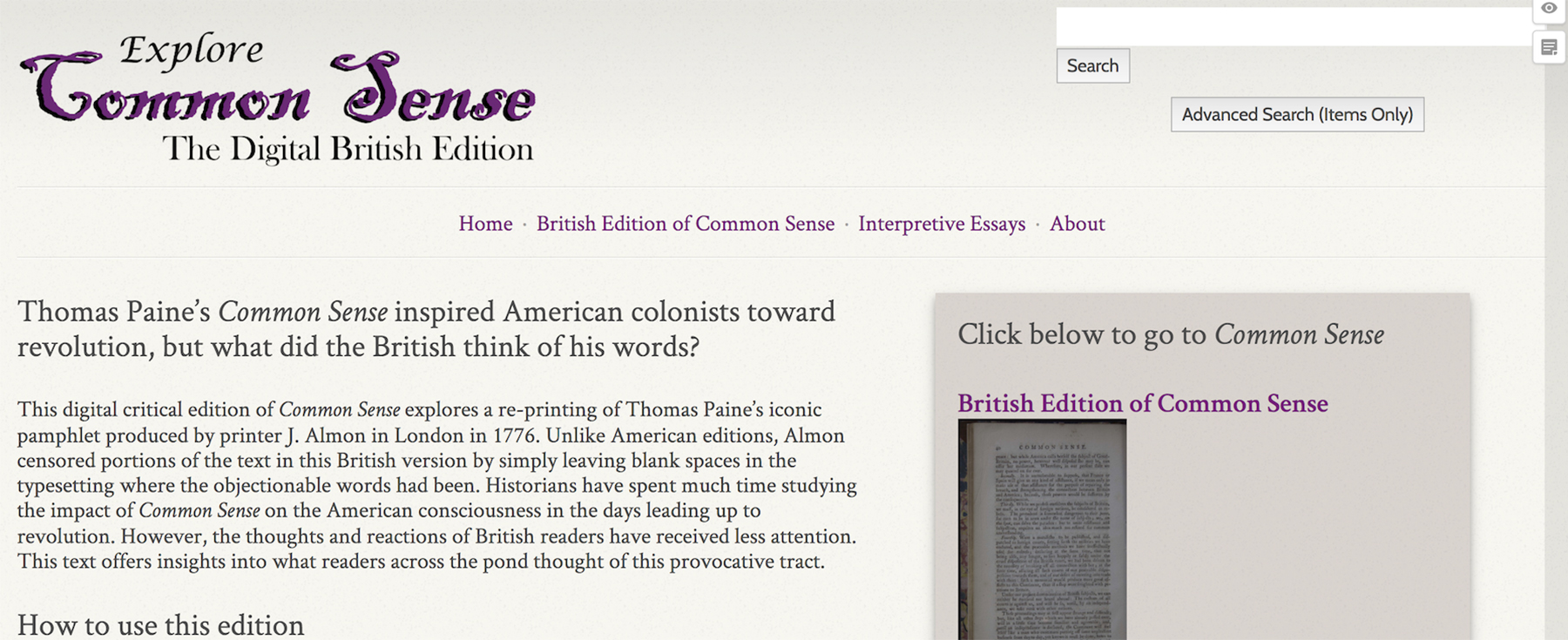
Mapping Religious Diversity in Modern Sichuan
Project Directors: Prof. Elena Valussi(Loyola University Chicago), Prof. Stefania Travagnin (University of Groningen and then SOAS, University of London). Details on the team can be found here.
Research Assistant: Prakruti Maniar
Status: Ongoing
Website: https://sichuanreligions.com/
Description: Mapping Religius Diversity in Modern Sichuan aims at discussing dynamics and paradigms of religious diversity in Sichuan in the Qing and Republican period. (1840-1949).
Historians of China have been increasingly interested in this extremely creative, if chaotic, period of time as central for the creation of Chinese modernity. Religion has only recently been part of the discussion, as publications and conferences have attested, but already provides an important lens through which to consider societal, political and cultural changes.
For this project, rather than concentrate on coastal areas or large urban centres as has been done in the majority of recent publications, we wish to focus on a lesser known and studied but extremely influential geographical area of China: Sichuan. Our aim is the study of religious diversity through the analysis of communities and networks, with a specific interest in interactions between rural/urban, public/private, religious/lay communities and spaces.
The DH component of this project was started in the Fall of 2019. Prof. Valussi collaborated with Prakruti Maniar, a Master’s student in the Center for Textual Studies and Digital Humanities of Loyola University Chicago. The collaboration made Ms. Maniar a DH Research Assistant for the Mapping Religious Diversity in Modern Sichuan project.
Fields: Buddhist Studies, Chinese History, Religious Studies, Daoism
The CTSDH supports and sponsors a series of online research projects in Textual Studies and Digital Humanities. These projects include, but are not limited to, digitization, text editing, tool building, critical analyses, and archive construction. They are created with a mix of internal and external funding, and interdisciplinary co-sponsorship. They typically involving affiliated Loyola faculty, staff, graduate and undergraduate students, in various areas and disciplines from across the university. If you want to house a project at the CTSDH, please check the 'Start a Project' page. Want to sample Digital Humanities in your classroom? Look at some of the ways we have done so in the past, on the 'DH in the Classroom' page.
At the CTSDH we are committed to nurturing student scholarship in the Digital Humanities and Textual Studies. Below you will find more information about projects undertaken by Loyola undergraduate and graduate students. Browse through and enjoy the diversity of creative work happening by the next generation of digital humanists!
